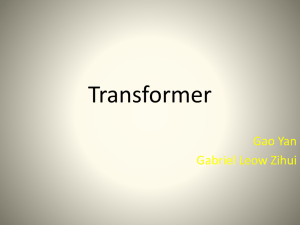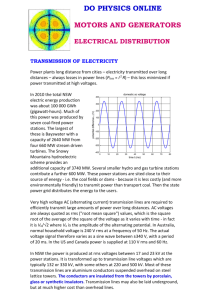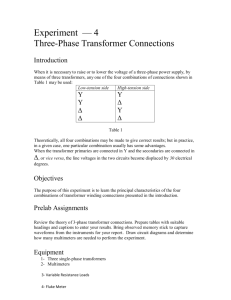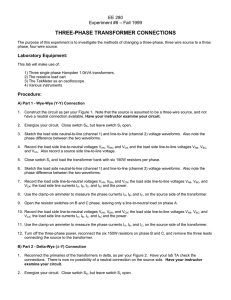PRELAB THREE-PHASE TRANSFORMER CONNECTIONS EE280 Experiment #6 – Fall 1999
advertisement
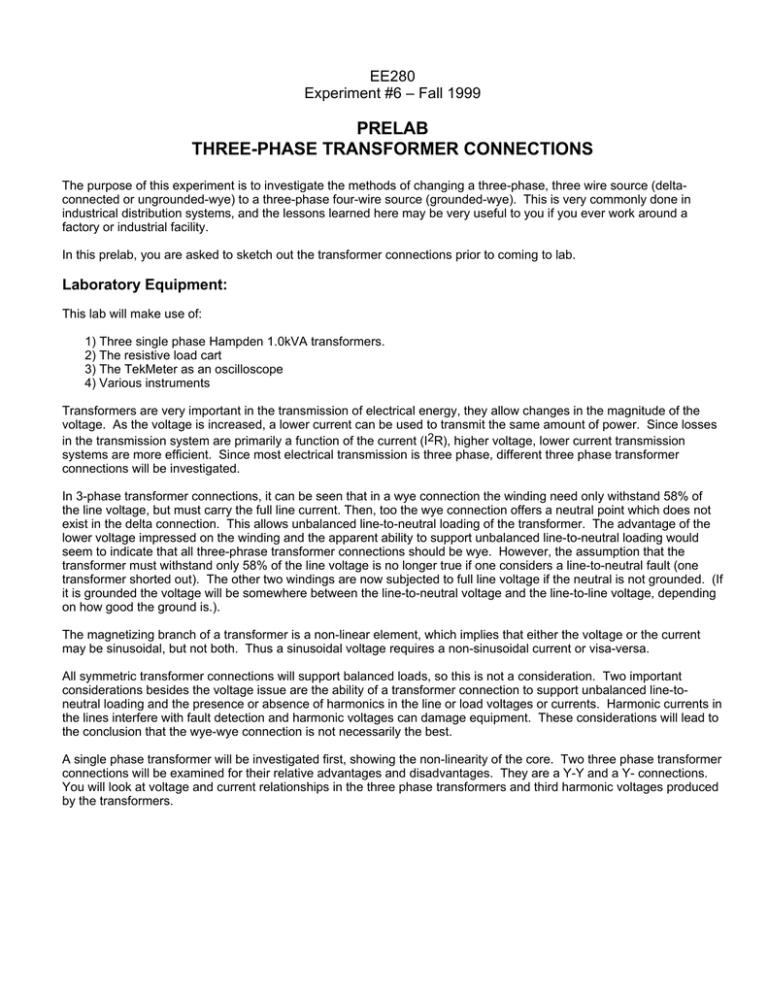
EE280 Experiment #6 – Fall 1999 PRELAB THREE-PHASE TRANSFORMER CONNECTIONS The purpose of this experiment is to investigate the methods of changing a three-phase, three wire source (deltaconnected or ungrounded-wye) to a three-phase four-wire source (grounded-wye). This is very commonly done in industrical distribution systems, and the lessons learned here may be very useful to you if you ever work around a factory or industrial facility. In this prelab, you are asked to sketch out the transformer connections prior to coming to lab. Laboratory Equipment: This lab will make use of: 1) Three single phase Hampden 1.0kVA transformers. 2) The resistive load cart 3) The TekMeter as an oscilloscope 4) Various instruments Transformers are very important in the transmission of electrical energy, they allow changes in the magnitude of the voltage. As the voltage is increased, a lower current can be used to transmit the same amount of power. Since losses in the transmission system are primarily a function of the current (I2R), higher voltage, lower current transmission systems are more efficient. Since most electrical transmission is three phase, different three phase transformer connections will be investigated. In 3-phase transformer connections, it can be seen that in a wye connection the winding need only withstand 58% of the line voltage, but must carry the full line current. Then, too the wye connection offers a neutral point which does not exist in the delta connection. This allows unbalanced line-to-neutral loading of the transformer. The advantage of the lower voltage impressed on the winding and the apparent ability to support unbalanced line-to-neutral loading would seem to indicate that all three-phrase transformer connections should be wye. However, the assumption that the transformer must withstand only 58% of the line voltage is no longer true if one considers a line-to-neutral fault (one transformer shorted out). The other two windings are now subjected to full line voltage if the neutral is not grounded. (If it is grounded the voltage will be somewhere between the line-to-neutral voltage and the line-to-line voltage, depending on how good the ground is.). The magnetizing branch of a transformer is a non-linear element, which implies that either the voltage or the current may be sinusoidal, but not both. Thus a sinusoidal voltage requires a non-sinusoidal current or visa-versa. All symmetric transformer connections will support balanced loads, so this is not a consideration. Two important considerations besides the voltage issue are the ability of a transformer connection to support unbalanced line-toneutral loading and the presence or absence of harmonics in the line or load voltages or currents. Harmonic currents in the lines interfere with fault detection and harmonic voltages can damage equipment. These considerations will lead to the conclusion that the wye-wye connection is not necessarily the best. A single phase transformer will be investigated first, showing the non-linearity of the core. Two three phase transformer connections will be examined for their relative advantages and disadvantages. They are a Y-Y and a Y- connections. You will look at voltage and current relationships in the three phase transformers and third harmonic voltages produced by the transformers. To Do: 1) Review Chapter 4 of the text. Pay particular attention to sections 4.5 (pg. 78-99) and 4.7 (pg. 102-109). 2) Bring this document, the lab procedures document, and the lab policy document to the lab 3) 4) 5) 6) The following are to be handed in before lab. MAKE A COPY FOR YOURSELF BEFORE HANDING IT IN Sketch out the circuit diagram for a Y-Y connection with zero-degree phase shift between primary and secondary. Refer to this as Figure 1 in the lab procedure. If balanced 3-phase voltage is applied with a 3-wire primary and a 4wire secondary, describe what happens when only one phase of the secondary is loaded (the other two phases are open circuited). Explain why this is so. HINTS: Consider that if there is current in one phase of the secondary, there must be current in the corresponding winding of the primary. If there is current in one phase of the primary, there must be current flowing in the corresponding winding on the secondary. Also, Kirchoff says that the currents at the neutral node must add to zero! Include a phasor diagram of the transformer voltages and currents. Sketch a circuit for testing a ∆-Y transformer with a standard 30-degree phase shift. Refer to this as Figure 2 in the lab procedure. (See Fig. 4.25(d) pg. 104). Use 3 single phase transformers. The primary should be connected in delta. Use the high voltage windings which are rated at 208V. The secondary should be in Y using the low voltage windings rated at 120 V. The load is to be the resistive portion of the load cart which will be connected in a wye. Construct the circuit so that you can measure a line to line voltage. Show spots to measure the primary phase current in the transformer and the primary line current. If a ∆-Y connection is applied with a 3-wire primary and a 4-wire secondary, describe what happens when only one phase of the secondary is loaded (the other two phases are open circuited). Explain why this is so. Include a phasor diagram of the transformer voltages and currents. Make data tables for recording the values of voltages and currents you’ll need to measure for all steps of the lab. This will make your lab go much faster!



